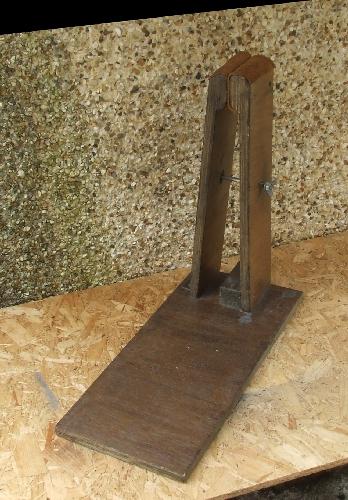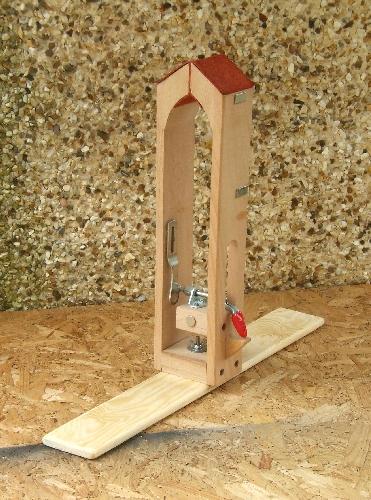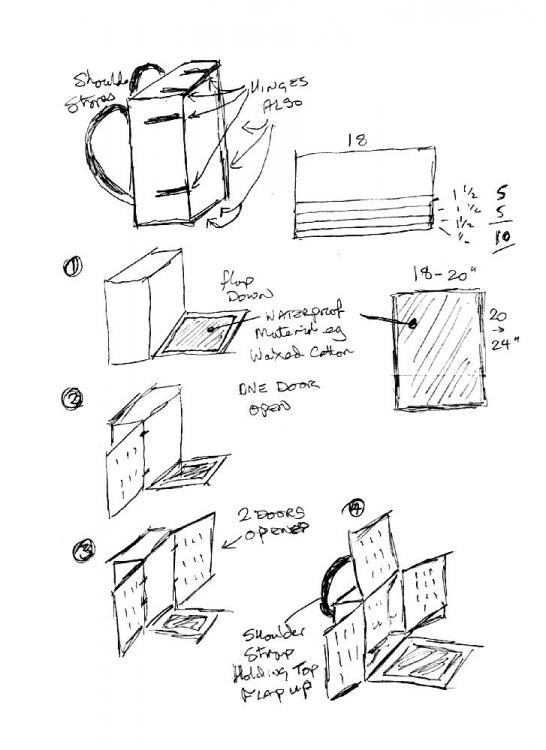-
Posts
5,928 -
Joined
Content Type
Profiles
Forums
Events
Blogs
Gallery
Everything posted by fredk
-
Well, seeing as we are doing a 'show and tell', here are my stitching clamps thingies #1, the first one I made over 20 years ago, still used occasionally. #2, as #1 is a bit tall I bought a cheap smaller one, cost under £10. I added magnets, changed the foot board and made it swivel-able. The spanner for the wing nut which locks the swivelling is held by a magnet on the inside. Maybe some day I'll add the springs I bought specially for these and maybe do other improvements. In the meantime some leather is calling me to cut and fashion it. . . . . .
-

Looking for a good (Cheap) scale and thickness gauge.
fredk replied to ToddW's topic in Leather Tools
I use a wee thickness gauge which cost me £3.50 but is sold by some for as much as £25. Its jaws only allow going into the hide by a couple of centimetres, but it is accurate It looks a bit like this one, just slight design differences -
I've used MrMuscle on leather boots and shoes to clean off oily gunge from my motorcycles or picked up in scrapyards. Spray on, leave for just a few moments, wash off, job done, but it is risky if you don't know what you're doing with it.
-
If the marks are dark and shiny, I think its the aluminium oxide rubbing off. Aluminium always has a layer of oxide on its surface. Spraying the area with MrMuscle oven cleaner might work as that dissolves aluminium, but thats risky as the MrMuscle might affect the rest of your boots.
-
I like magnets on mine. Somewhere for the needles to hang whilst I move the project in the jaws or just when I want to have a break from sewing. Also, a handy place to hang the awl, spare needles, if required. Never had thread hang up on them
-

Important Customs news for UK/Eu leatherworkers
fredk replied to fredk's topic in Marketing and Advertising
I dunno what 'Reddit' is. But so far its been the Eu breaking the rules which were agreed. Assurances nothing would hamper drugs supply; the Eu blocked supplies of Astra Covid Vaccines back in January. They have imposed regs on the transportation of horses; a judge had to over-rule the suddenly imposed regs which would have led to the deaths of horses coming from GB. Eu imposed regs on 'soil' imported into N.I. Farmers and building contractors could not bring their machinery back from Scotland if there was so much as a speck of dirt on them - I do not exaggerate. One farmer who owns land in N.I. and Scotland could not bring some of his machinery back, it was stopped by customs 'in case' there was 'soil' on it. N.I. produces a lot of meat, it is sent over to GB for further processing, eg made into oven-ready meals, pies etc, but from this weekend the shops cannot bring that produce back over! And there is so much more which is known on the local scene and not reported by papers. Eg, petrol stations ran out of diesel fuel for a period of 5 days. The main fuel suppliers had problems with some of the new Eu regs (some of those 800 which have been applied in the last few weeks) It was the Eu which demanded the Irish Sea Border. After enquiring why my post has been late, the Royal Mail tells me all post is now going to and from GB through customs checks which is making an average delay of 5 to 6 days per item. Today I received a packet from GB posted on July 19th, (10 days) yesterday I received a packet from China posted there on July 20th. (8 days) -

Important Customs news for UK/Eu leatherworkers
fredk replied to fredk's topic in Marketing and Advertising
I cannot show you the info sent to me by my MLA - a government minister. Its confidential in nature However, scan down through this on-line news story. about 1/4 down, just above a photo of M. Martin https://www.express.co.uk/news/politics/1463424/brexit-live-news-ursula-von-der-leyen-visit-ireland-micheal-martin-northern-ireland and The Belfast Telegraph news report https://www.belfasttelegraph.co.uk/news/northern-ireland/eu-dropped-800-new-regulations-on-northern-ireland-without-notice-says-government-40654157.html -

Important Customs news for UK/Eu leatherworkers
fredk replied to fredk's topic in Marketing and Advertising
The EU just imposed 800 new rules in the last three/four weeks. Rules which were not agreed upon at all. The UK knew what they signed up for but not these 800 new rules which if not obeyed the EU will take the UK to court. The court action has already been started. And there are to be a further 1200 new EU regulations by Christmas time -

Important Customs news for UK/Eu leatherworkers
fredk replied to fredk's topic in Marketing and Advertising
Latest info; a rant! The 'Grace' period of N.I. imports is coming to an end now and things are looking bad. Shortages of fresh fruit and veggies and other foods in the shops*. From this weekend the main shops will not be allowed to bring in processed meats, eg sausages, pies, sausage rolls. The local Royal Mail tells me there is excess of 5 million postal items from N.I. to GB sitting in Liverpool docks waiting to clear customs, and approx 10 million postal items from GB to N.I. Worse is that over 2000 types of regular pharmaceutical drugs are no longer allowed into N.I. Those are drugs Ill people need. The Jewish community here, only about 250 people, cannot get their Kosher foods * in 1980 I spent a holiday in Jugoslavia and not since then have I seen food shelves in supermarkets totally empty or some with buying restrictions on them eg, 'Only two items per customer' I know you guys aint stoopid but let me put this in a context for you; imagine that all goods and mail in and out of Texas going to the other 49 States has to go through 'customs' because Mexico says it has to. And Mexico also puts restrictions on what meats, bread, fruits and veggies and other goods are allowed into Texas to be sold. Maybe Uncle Joe would allow it but Brother Donald sure wouldn't! PS. I was in touch with Le Prevo who got in touch with the courier. Each hide I buy would need a certificate signed off by a qualified veterinarian (we call them vets) which would cost approx £35 to £50 per. Thats on top of the other courier fee! So 5 hides which used to cost me £16.50 delivered would now cost about £265 to £340. Roughly, the same sort of hides from Tandy in Texas would cost me £32 delivery - inc all taxes! The Le Provo courier cost is not 100% certain. I'm told, buy, get shipped and see what charges will be made, but I can't afford to take that risk But, as Baldrick would say; I have a cunning plan. As cunning as a cunning fox teaching cunning at the university of cunning. I have a friend in England I could get the Le Prevo hides shipped to . . . . -
That is true, but for why would you want it adjustable over a large range? I wear the one size of hat. My different hats' thickness of material only varies but a couple of mm overall. One time I measured around 4 of my hats with the idea of making bands for them. The length of the band around only varied 5mm between the shortest and longest
-
I dunno how the maker has dun it but if it was me I'd hide a couple of snaps behind that tongue,. Actually, maybe two or three half parts of snaps on the tongue and one half (the counter part to the others) on the strap between the end and the keeper, then the strap can be adjusted a wee bit
-
Move both the leather and the knife
-
Is the adjustment lever screwed tight with a reverse screw thread?
-
How long ago was this? As you have a postal address I'd send a letter. Include something along the lines that she still owes you $1500 for the sample tack. People usually fall for that and will respond by saying they don't owe you anything for the tack, which, if they word it in a certain way acknowledges that they have it Do you have one of those 'better business bureaus' that I sometimes read of? Go there and see if they can advise you. No sense me advising you, or some of the others on here, as the remedy available to us may not be the right one for you in Mn Don't feel bad yourself. Most of us have been in this situation at sometime. Its a calculated risk that sometimes needs to be taken. Sometimes it pays off, sometimes we get ripped off
-
Me too. I just slashed the top of the bag open with a knife and tipped it into the meal bin
- 31 replies
-
- stitch
- identify the stitching
- (and 3 more)
-

Do you moisten your leather before dying with Pro Dye?
fredk replied to Jenn64's topic in Leatherwork Conversation
Whatever type of dye I use I dampen the grain side of the leather before I dye and as I dye it I reckon it helps the distribution of the dye thru the leather, giving me less patches of differing colour density. Initially the dye colour might be light but I just apply more coats of dye to get an even depth of colour -
Could you get a similar thread pattern using the Auto-Awl? Maybe not just as its supposed to be used but by altering how you do the looping of the thread
- 31 replies
-
- stitch
- identify the stitching
- (and 3 more)
-
I've enjoyed reading all your responses and seeing all the cases / packs you've found Just shows ya, a good idea just stays around and is adapted by different trades In the 1100s thru 1500s ordinary people wore a hood with a short shoulder length cape attached (actually it was one piece). In the old illustrations the chapman's hood-cape draped over the top of his pack. It looked like he'd put the pack on first, then his hood, which draped over his shoulders and the rear part covered the top of his pack I never photo'd it and afaik no else bothered to either. It was no great shakes. It was just a rough one knocked up to see if it was useful. Plan was to make a better one Good one. Looks like they continued a profession which went back to at least the 900s yeah, well, I was sort of teasing on that. I did get slightly more attention from both visitors and the press. If you've seen one Black Knight sword fighting you've seen them all but it's not often there was someone (me) sitting making arrows, or sewing up shoes etc Oh, another version; the knapsack, aka a backpack, used by British soldiers during the Napoleonic Wars (1793 - 1816) and by US soldiers from about 1811 was of a similar construction and opened up in the same way. The Froggie's / Crapaud's pack was different Now that we have all these variations who will be the first to draw up a pattern for one they might use? 'Be the first on your block!' as adverts on the back of comics used to say
-

A Part Time Gun Show / Renn Faire Business
fredk replied to austinious's topic in Marketing and Advertising
You can buy LED lamps which look like Tilley oil lamps. They are aimed at campers I can't find the one I'm thinking of but here is another example https://www.amazon.co.uk/Camping-Lantern-Sahara-Sailor-Collapses/dp/B076K13QVV/ref=sr_1_26?adgrpid=50624903462&dchild=1&gclid=Cj0KCQjw6NmHBhD2ARIsAI3hrM2BgjO5_WcjyCyWOvQtd30j8F2oIQRDRXsF7vGWGA5G-8Tuj3rDGF8aAprlEALw_wcB&hvadid=259034948109&hvdev=c&hvlocphy=1006500&hvnetw=g&hvqmt=e&hvrand=11031287559302580435&hvtargid=kwd-297169368403&hydadcr=28153_1821061&keywords=led+camping+lights&qid=1626821317&sr=8-26 -
I think if you understand and visualize what goes on may help Your awl blade tapers from the point to its maximum width. You need to get the blade to a part of its maximum width thru the hole, not just a bit of the taper. As soon as you withdraw the blade the leather starts to close back up, thus you need to get your needle into that hole real fast, in fact, as you withdraw the awl blade the needle should be going in and coming out the other side with the awl blade. If you are saddle stitching the second needle should be going in now once the tip of the awl blade is clear of the hole. Now you'll feel resistance to the thread going thru the hole but if the thread is well waxed it'll pull through
-
Last first. Yes, undoubtly but imo, not until you have gained some experience. Cheap tools will get you going, then buy the expensive ones when you're sure you'll use them I use these pliers type sewing holes punches. They do 2mm diamond holes at 2mm spacing. They are good for general sewing. Available in 4-tooth as per photo and 2-tooth for going around curves
-

A Part Time Gun Show / Renn Faire Business
fredk replied to austinious's topic in Marketing and Advertising
rather than hi-jack this thread I did a thread on a Chapman's Pack https://leatherworker.net/forum/topic/96513-chapmans-pack-for-renn-faires-and-markets/ -
On another discussion I mentioned a Chapman's Pack. @Klara asked what a Chapman's pack looked like. She could not find an example via google. In medieval times the chapman was a travelling shop. He came around your area every once in a while. He brought his stock of household requirements in his pack. He brought needles & threads, thimbles, eating knives, spare buckles to repair old belts, he brought toys for children, confections, cheap jewellery, ribbons & lace and more to sell to village and country housewives. One thing he brought which was priceless was the latest news from around the Kingdom or just the next parish or village The chapman travelled alone on foot in person but usually had a dog to accompany him and for protection. He did his rounds just about every day of the year, no selling on Sundays though and except in the very worst of weather. He got shelter and food from his customers and at Abbeys. He carried his shop on his back. Very rarely was he ever robbed. He was one of those who bandits never really bothered, he was just an ordinary workman earning his living. When I was involved with historical presentation societies I choose to be the simple craftsman whilst everyone else wanted to be the 'Black Knight' and do the sword fights. Guess who got more attention? More photos in local & national papers? Towards the end of my time doing events I made a basic Chapman's Pack but was planning on making a better one. Just opening up the Pack drew crowds of attention at events My pack is based on several drawings which were in the margins of early illuminated books, mainly from the early to mid 14th century (the 1300s) Herewith is a basic sketch outline of what a Chapman's pack looked like and how it was opened up The box shape is made of extremely thin and light weight wood, about no more than 1/8 inch thick for the panels and the frames about 1.5 to 3 inches thick. My sketch is very basic. Those who study it will realise that the depth of each main side, top & bottom piece is different to accommodate the thickness of the panels when they are folded in. Generally the pack was about 18 to 20 inches wide, the width of a strong man at the shoulders. It was about 20 to 26 inches tall, from top of shoulders down to arse and between 8 and 16 inches deep. The rear-most panel had waterproof material on it as it was first on the ground when opened and when up it closed off the contents from wind and rain. Each panel opening in its sequence. The hinges were often of hardened leather. Each side panel and top opening panel, or flap, had various ways to hang the Chapman's wares for display. Some cheap items just being laid out the ground flap, the goods protected by the waterproof cover. The most expensive items remaining in the main box of the pack but could be seen. The shoulder straps would be unbuckled and re-attached to the flap to hold it up. Rarely, the chapman also carried, attached to the pack, 4 wood shafts, each about 3 ft long which he could attach to the base of the pack somehow to raise the pack up, to make it easier for customers to see his goods - no kneeling down, better for elderly housewives in market places Obviously there can be a great many variations on this design
-

I phone wallet
fredk replied to Frodo's topic in Purses, Wallets, Belts and Miscellaneous Pocket Items
Its been a while since I done that My usual, sometimes too bluddy often, mistake is to take what I think is a waste off-cut and think 'That piece will do nicely for this, it just needs cutting down to shape' then after its been cut down, its 'Oh Sh*t' as I realise that piece was a cut piece for an on-going stalled project. And invariably it was the last good piece available for the stalled project. No repair. You'll not be happy or content until you remake & replace that slashed panel. And it'll be one of the bestest panels you'll ever do!





